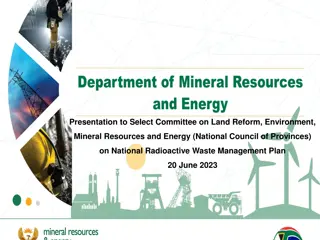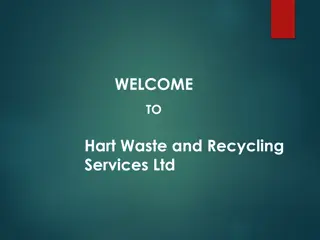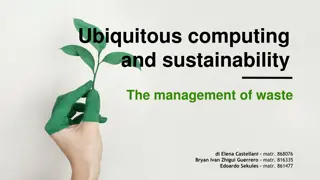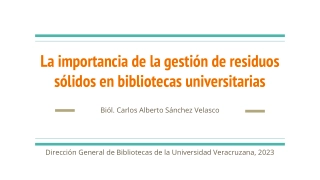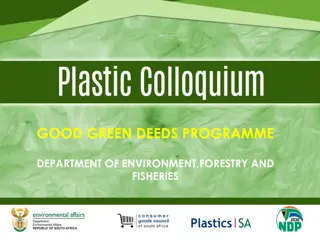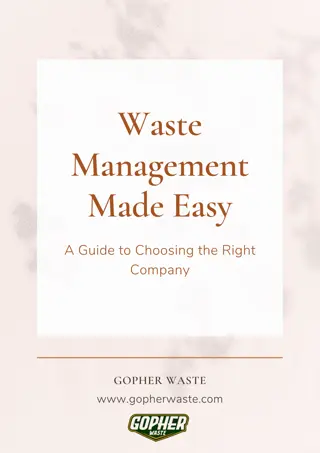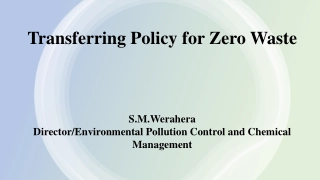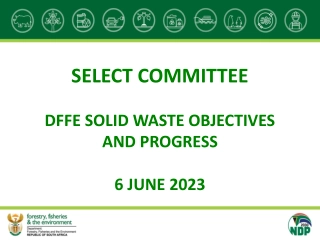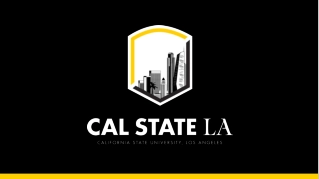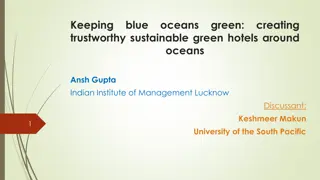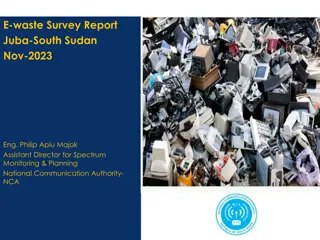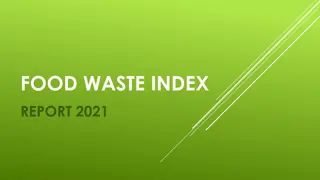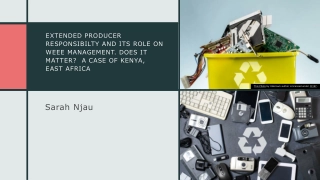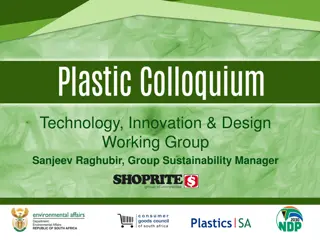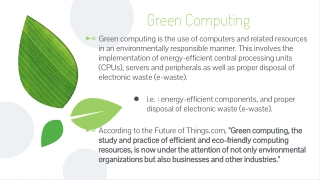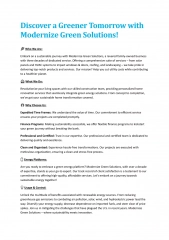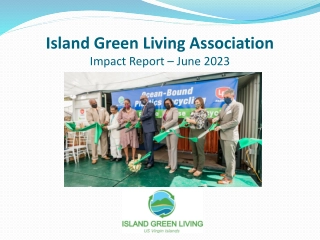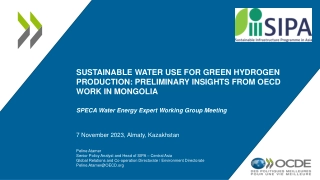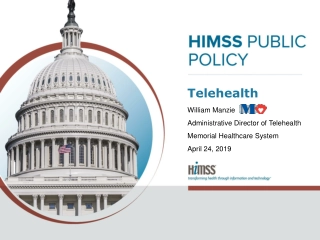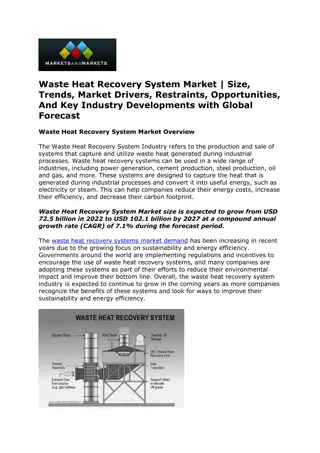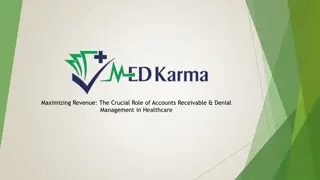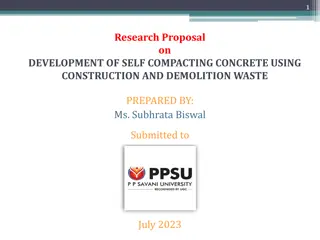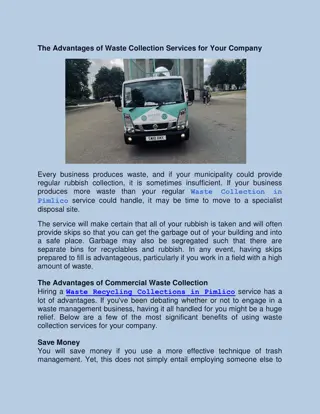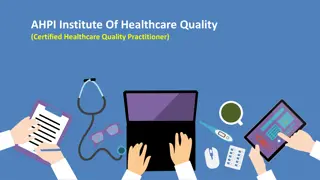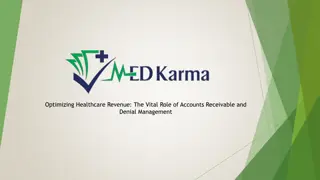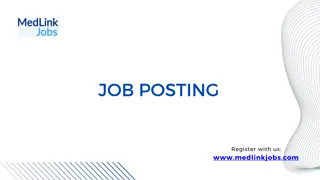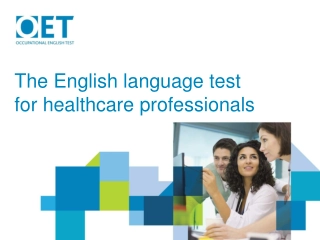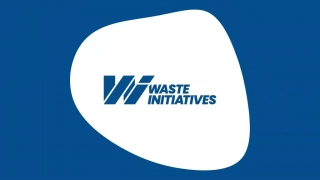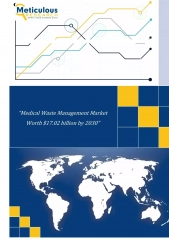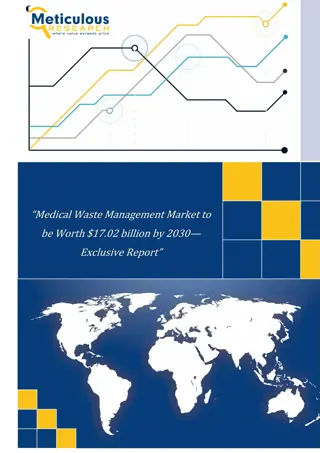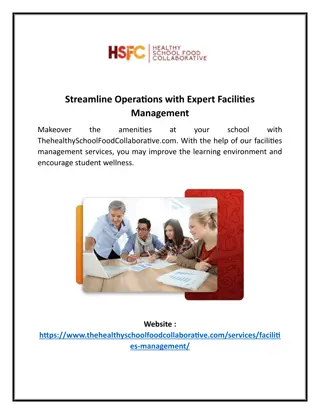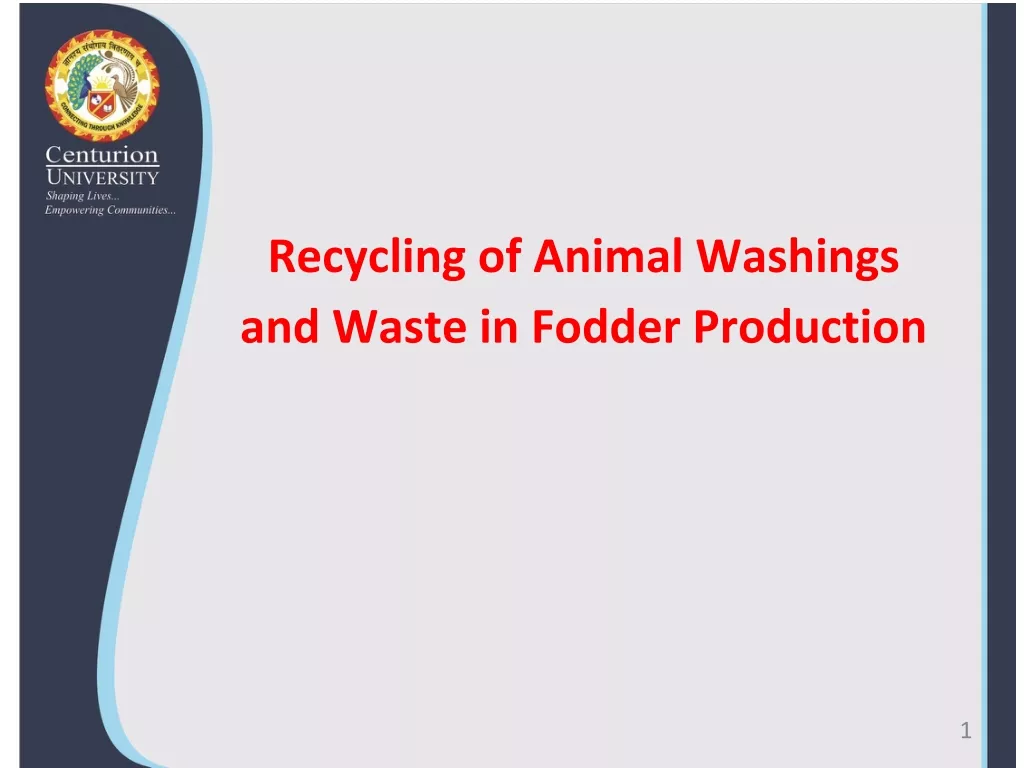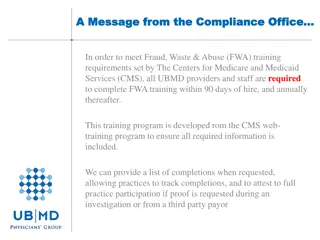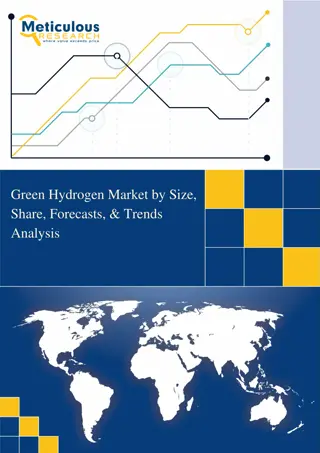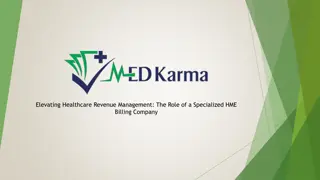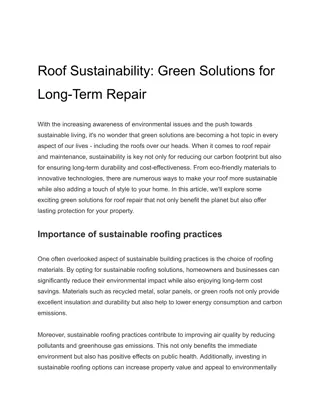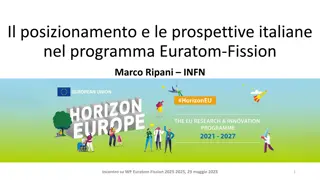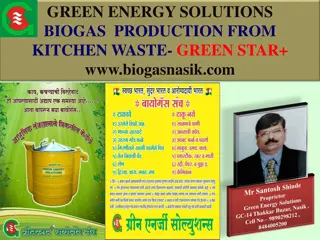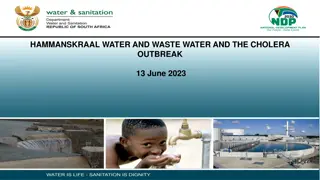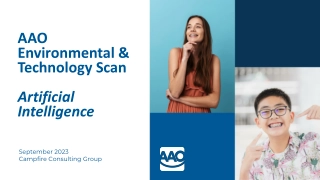Sustainable Waste Management and Green Technologies in Healthcare Facilities
The healthcare sector contributes significantly to global greenhouse gas emissions, emphasizing the need for sustainable waste management solutions. The selection of treatment technologies in health facilities is crucial, considering regulations, waste generation, technology capabilities, budget constraints, and available resources. A hierarchy of waste treatment options highlights preferred, interim, and last resort solutions. Specific technologies like low-heat vacuum autoclaves play a key role in environmentally friendly waste treatment practices.
- Sustainable waste management
- Green technologies
- Healthcare facilities
- Waste treatment
- Environmental impact
Sustainable Waste Management and Green Technologies in Healthcare Facilities
PowerPoint presentation about 'Sustainable Waste Management and Green Technologies in Healthcare Facilities'. This presentation describes the topic on The healthcare sector contributes significantly to global greenhouse gas emissions, emphasizing the need for sustainable waste management solutions. The selection of treatment technologies in health facilities is crucial, considering regulations, waste generation, technology capabilities, budget constraints, and available resources. A hierarchy of waste treatment options highlights preferred, interim, and last resort solutions. Specific technologies like low-heat vacuum autoclaves play a key role in environmentally friendly waste treatment practices.. Download this presentation absolutely free.
Presentation Transcript
Technical Series on WASH, waste and electricity in health facilities Healthcare Waste and Green Technologies 5 December 2023 Dr Ute Pieper, WHO Consultant (WHO WASH)
Key facts Key facts Climate change and the health sector Healthcare's climate footprint is 4.4% of the global total. If the global health care sector were a country, it would be the fifth- largest greenhouse gas emitter on the planet. Source: Arup / HCWH, Healthcare's climate footprint, 2019 2
Key facts Key facts Sources of greenhouse gas emissions Globally, greenhouse gas emissions in 2019 were 1. electricity and heat (31%) 2. transportation (17%) 3. manufacturing & construction (12%) the 3 primary sources of All the shown sectors are directly or indirectly connected to carbon footprint of the health sector. Sum: 51.0619 billion t Waste in specific: ~ 3,2 % Source: https://www.climatewatchdata.org/data-explorer/historical-emissions 3
Selecting of treatment technologies Selecting of treatment technologies The choice of treatment system is contextual and involves consideration of: National & international regulations Environmental and occupational safety factors Type & quantity of waste generated Technology capabilities and requirements Available budget (for investment and maintenance) Operation and maintenance requirements Infrastructure (space) Available energy (electricity, water, fuel etc.) 2 Available final disposal options (recycling, landfill) https://www.who.int/publications/i/item/ 9789241516228 WHO s overview of technologies provides guidance for health care facility administrators and planners, WASH and infection prevention control staff, national planners, donors and partners.
Hierarchy Hierarchy of of waste waste treatment treatment options options 1. Preferred options: Technologies in accordance with International Conventions 2. Interim solutions: Technologies used to incrementally improve practices and move towards meeting international standard 3. Last resort option: Where there are no alternative treatment options 2 Final disposal Minimization Segregation Collection Transport Storage Treatment 5
Low heat: Vacuum Autoclaves Low heat: Vacuum Autoclaves Steam injection Treatment Vacuum I n s i d e - P r e s s u r e Air is mechanically removed by a vacuum- pump: single pre-vacuum or fractionated vacuum 2 bar Decontamination of waste at 121 134 C by steam 1 bar Considerations: Waste is recognizable: 0,1 bar Time It can be reused (e.g., illicit reselling of vials) It can be recycled (e.g., plastic of the syringes) 380/400 V or 240 V electricity connection is needed Reliable water connection and specific water quality (soft water)
Hybrid Hybrid Autoclaves ( Autoclaves (with with shredder shredder) ) The waste is shredded before treatment ensure that the steam can reach all surfaces of the waste for decontamination. Considerations: Shredders are expensive (investment and operation) 380/400 V electricity connection is needed Reliable water connection Waste is rendered in small pieces (shredder): Waste is unrecognizable Reduction of volume Illicit reselling of decontaminated materials not possible
Waste Microwaves with shredder Waste Microwaves with shredder In modern non-vacuum system, waste must be shredded prior to the disinfection process. The shredded waste gets in the treatment chamber and will be transported by a screw for a defined time. Here, it will be penetrated by steam at a temperature of about 100 110 C. The steam will be produced by microwaves, or the transporting screw will be heated by thermal oil. Considerations: Shredders are expensive (investment and operation) 380/400 V electricity connection is needed Waste is unrecognizable / reduction of volume / NO Illicit reselling of decontaminated materials possible No or little use of water Note: waste must be humid to guarantee heating up by the microwaves! Some microwaves have a water injection technology included.
With or without shredder? With or without shredder? Electricity considerations MICROWAVE WITH SHREDDER AUTOCLAVE WITHOUT SHREDDER Electricity: 380/400 Volt Electricity: 380/400 Volt Water connection Water connection (some brands) Quality of water for steam generation: soft water / demineralized water 100 Wastewater connection 60 56 45 40 21 20 17 7 40 70 150 500 800 Capacity kg / cycle 100 175 300 500 Capacity kg / cycle Energy Consumption (kWh / cycle): Energy consumption (kWh/cycle): Note: one cycle of a washing machine consumes 0,6 to 1 kWh (7 kg/cycle) = 500 kg / cycle would be 42-71 kWh (like the autoclave in this example)
Case Study: solar energy use for Case Study: solar energy use for autoclaving in Madagascar autoclaving in Madagascar Result of the UNDP GEF project Africa Installation of an 80-liter waste autoclave in a referral hospital (15 kg of infectious waste per day) Infrastructure: Housing was constructed (storage room, autoclave room) Electricity connection: high voltage (3-phase), 380 Volt Water connection Obstacle: not sufficient budget for electricity Solution: solar PV panels of total 3 kW capacity based on a Silicon monocrystal technology was installed on the roof (including 200 Ampere Batterie) The PV system was installed in summer 2018 providing about 25% of the total electricity consumption of the hospital
Conclusions/recommendations Conclusions/recommendations Think out of the box: How to minimize the generated waste? Is reverse logistics possible to prevent onsite waste treatment Can central waste treatment technologies be used? Is the solarization of the HCF an option to operate non-incineration technologies? The local situation must be assessed to select the best available option for the specific situation (water, electricity, space, capacity, budget ) Alternative treatment technologies should be preferred to incineration (no greenhouse gas emissions, no hazardous ash) Technologies with integrated or post shredder is more energy (and cost) intensive as an additional process is included advantage: the waste is unrecognizable. The cost of the technology is not only the investment but also the ongoing operation and maintenance costs.
For more information and to get involved contact: washinhcf@who.int Thank you and Join the Action WASH in HCF knowledge portal: www.washinhcf.org Twitter: @WASH_for_health
Technical resources Documents & Tools Global analysis of health care waste in the context of COVID-19 (2022) WASH and COVID 19 technical brief (2020) Overview of technologies for the treatment of infectious and sharp waste from health care facilities (2019) WHO Safe management of wastes from health care activities (2017) IPC/WASH Covid guidance WHO manifesto for a healthy recovery from COVID-19: prescriptions and actionables for a healthy and green recovery (2020) Compendium of WHO and other UN guidance on health and environment (section on priority settings, including health care facilities (2021) WASH FIT Tool Websites & Social Media Videos & Courses Cleaning and Disinfection Waste Management Training modules in health-care waste management COVID-19 and work: Staying healthy and safe at work during the COVID-19 pandemic Healthy and safe telework Occupational health and safety for health workers in the context of COVID-19 All-Hazard Rapid Response Teams Training Package Occupational safety and health in public health emergencies: a manual for protecting health workers and responders HealthWISE - Work Improvement in Health Services WHO WASH health care waste page WASH in Health Care Facilities portal WHO Infection prevention and control page WHO occupational health page Infographics Sudden increases in volumes Keeping health workers safe Follow the waste hierarchy model Nearly 1/3 of PPEshipped cannot be safely bagged or stored The COVID-19 response is generating a mountain of extra waste Training SEARO- Certificate in health care waste management Global- OpenWHO e-learning course on standard precautions in health-care waste management HCWM module of WASH FIT 3-day basic course on HCWM Training modules in health-care waste management - 25 Modules Environmental cleaning in the context of Covid-19. Monitoring and valuing WASH and waste services in health care facilities for safer, more equitable care.
Health Care Waste & Green Technologies UNDP DIGITAL HUB & INDONESIA COUNTRY OFFICE 5 DECEMBER 2023
Challenges of Medical Care Waste and Green in Indonesia Poor Visibility Poor Waste Segregation Inefficiency VS Incomplete and Delayed Report Unmatched Treatment Capacity Vs. Waste Burden Multiple Stakeholders (MoH, MoEF, third party)
Negative Impact Health and Environmental Hazard or Contamination High Cost Illegal Dumping
What is ME-SMILE? MEDICAL WASTE IN SMILE Real-time management and monitoring of medical waste based on website technology and mobile applications integrated with IOT (Internet of Things) Digital Scales and QR Label Scanners that are efficient and easy to use for accountable labeling, weighing, recording and reporting of medical waste data. Technological innovation to strengthen the medical waste chain system in Indonesia.
ME-SMILE Project Design Informed-Decisions Software Hardware Human Resource
ME-SMILE Key Features Cloud Server Ministry of Health s Mobile App and Dashboard Operation in Ministry of Environmental and Forestry s Dashboard IoT Scales Real Time, Accurate, and Accountable Data Identified segregated waste bags from unique code (QR)
Supporting Policies Waste-related Digital-related WHO Safe management of wastes from health-care activities, 2nd ed, 2014 Global UNDP Digital Strategy 2022-2025 Overview of technologies for the treatment of infectious and sharp waste from health care facilities, WHO 2019 Law number 32 year 2009 on Environment Government Regulation number 22 year 2021 on Environmental Protection and Management. Minister of Environment and Forestry Regulation number P.56 year 2015 on Healthcare Waste Management. Indonesia Ministry of Environment and Forestry (MoEF) Law number 17 year 2023 on Health Government Regulation number 66 year 2014 on Environmental Health Minister of Health Regulation number 2 year 2023 articulates the Government Regulation number 66 year 2014 on Environmental Health Minister of Health Regulation number 18 year 2020 on Healthcare Waste Management. Minister of Health Regulation number 17 year 2019 on Environmental Health in Hospitals Indonesian Health Transformation, 6th Pillar - Transformation of Health Technology Indonesia Ministry of Health (MoH) Regional-Based Digital Health Transformation Strategy 2024
ME-SMILE Technical Guidelines for Health Facilities Standard Operating Procedure (SoP) Implementation SoP is developed signed by The implementation is regulated by the MoH Dr. dr. Maxi Rein Rondonuwu, DHSM, MARS Director General of Disease Prevention and Control dr. Anas Ma ruf, M.K.M. Director of Environmental Health
ME-SMILE Piloting and Scale-up 2022 2023 3 health facilities in 2 Provinces 33 hospitals in 4 provinces
ME-SMILE Piloting and Scale-up 2022: 3 health facilities in 2 Provinces 2023: 33 hospitals in 4 provinces
ME-SMILE Mobile Application Scan QR code Add data Waste recap Reports Notifications Profile
ME-SMILE Web Portal Room/Ward List Print label Follow-up Reports - Graph Notifications Profile
ME-SMILE Corrective Measures Alert System 1 up Late Waste Pick- 2 Generated Waste > Storage Capacity Late Waste Generated Waste > Capacity of 3 Treated 4 Treatment
ME-SMILE Achievements in numbers 583.741 1 ton 1.900 ton Total transactions in ME-SMILE Average of Daily Waste Generated Total Waste Generated 32 Hospitals & 1 Health Centre in 18 Districts, 4 Provinces 33 841 3 Hours IoT scale installed in 33 Health Facilities Sanitarians trained Implement ME-SMILE (July 2023) Time Saving (manual vs ME-SMILE) Data as of 1 Oct 2023
ME-SMILE End to End Standard Operating Procedures QR Code Labels Printing + Sticking + Distributing Moving waste to temporary storage Weighing & deciding the next step Hazardous waste temporary storage/ cold storage 1 2 3 4 5 Segregation Loading, recap of results, and manifest filling Disposal or Recycle 6 7 8 9 Transporting Treatment A Waste is transported immediately Starting from here, it is processed by a third party (Transporter) QR coded residue bag 6 7 8 9 1 1 12 10 Loading, recap of results, and manifest filling Incineration Weighed waste residues Hazardous waste temporary storage Transporting Landfill B Internal waste treatment using incinerator Starting from here, it is processed by a third party (Transporter) 6 7 8 9 1 1 12 Autoclaved/ Chlorinated/ Microwaved Non-hazardous waste temporary storage 10 Loading, recap of results, and manifest filling QR coded non-hazardous waste bag Weighed non-hazardous waste bag Transporting Recyclers C Internal waste treatment using autoclave Starting from here, it is processed by a third party (Beneficiary Transporter)
ME-SMILE Result The initiation of ME-SMILE, 100% reporting rate and 100% are in complete report has been maintained. The system has shortened the duration of weighing process during waste loading in hospital from 3 to 0.5 hour, and increased the accuracy of measuring the weighing of waste during collection and transporting.
ME-SMILE Benefit Safe environment and better health Cost efficiency Segregated waste (infectious waste costed more than non-infectious) Less contamination due to segregated waste QR coded scanning process: minimize direct contact of operator to waste while weighing, loading & data input Increased weight accuracy Recycled waste for (health facility) income generating Monitor waste location Safe time & human resources More control to waste
ME-SMILE Key Uptakes Government Engagement Software: ownerships of source code, open source Field based sanitarians, transporters - involvement Show evidence or example from UNDP (similar solution)
Ask Me any ME-SMILE things... a smarter way to manage waste in health facilities
Greener and Safer Healthcare Greener and Safer Healthcare Waste equipment Waste equipment What motivated UNICEF EAPRO to focus on health care waste equipment? COVID-19 context increased the volume of waste to treat Immunization COVID-19 workplans lacked: Resources Infrastructures Tools Budgets Green and safe equipment Publications from UNICEF and WHO
What influenced UNICEF EAPRO to green and safe? What influenced UNICEF EAPRO to green and safe? The ultimate aim should be use of non-burn technologies such as autoclaves (section 4.3.3) Over time, non-burn technologies cost less (section 4.3.3) World Health Organization (Feb 2022). Global analysis of healthcare waste in the context of COVID-19: status, impacts and recommendations. World Health Organization. https://apps.who.int/iris/handle/10665/351189. Licence: CC BY-NC-SA 3.0 IGO
UNICEF & WHO COVID UNICEF & WHO COVID- -19 vaccination: vaccination: supply and logistics guidance (February 2021) supply and logistics guidance (February 2021) 19 Section 6 of the guidance: Follow the national guidelines and codes for final disposal if these are not available: Preferably use best available technologies in accordance with the Stockholm Convention, such as decontamination of waste by autoclaving or similar procedures or high- temperature incineration. World Health Organization & United Nations Children's Fund (UNICEF). (2021). COVID-19 vaccination: supply and logistics guidance: interim guidance, 12 February 2021. World Health Organization. https://apps.who.int/iris/handle/10665/339561. Licence: CC BY-NC-SA 3.0 IGO
WHO Guide about infectious waste treatment (2019) Technologies: . Autoclave . Microwave . Heat-Friction https://www.who.int/publications/i/item/97892 41516228 38 | Title of Your Presentation
U N IC E F E A P R O S OL U T ION Establish a regional LTA to help countries procured high quality, greener and safer equipment AIMING AT SOLUTIONS THAT WOULD OFFER: Reduction of unsafe risks to the healthcare workers during waste management operations Reduction of exposure to dioxins and furans to the health workers, their communities and the environment Reduction of waste volumes in health facilities; and Bundled services, such as: installation, training, and 2-yrs warranty of HCW treatment equipment
Greener and Safer Greener and Safer Healthcare Waste Healthcare Waste equipment equipment April 2022 Published RFI 22 manufacturers and suppliers responded positively March 2023 Published RFP 11 manufacturers responded November 2023 Awarded 5 LTA RESULTS
U N IC E F E A P R O S U P P OR T How to choose the RIGHT technology according to the COUNTRIES CONTEXT Guidance and Webinar: A technical guide on how to choose the BEST TECHNOLOGY according to a country context, such as: availability of water, energy, operational economy and reduction of carbon emission A technical guide on how to procure the products using the regional Long-Term Agreements Webinar where each manufacturer will present their product and where best practices will be shared by countries


